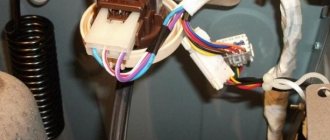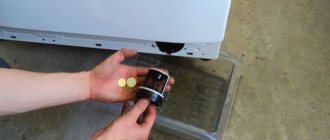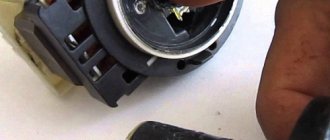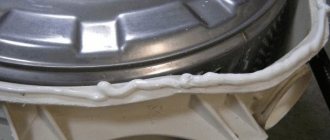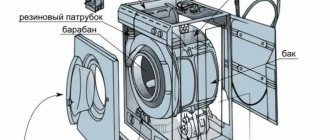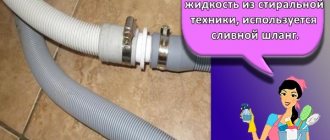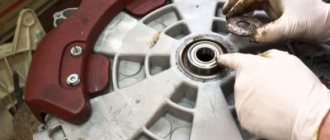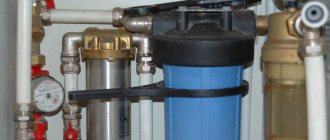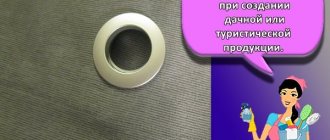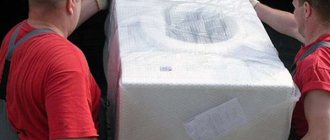Returning liquid from the drain back into the washing machine tank is very unpleasant. Dirty laundry, terrible smell and spoiled mood. The main reason is improper installation of household appliances. The problem can be solved by installing a check valve on the drain.
Let's figure it out:
- how antisiphon works in practice,
- how to install the element correctly,
- What recommendations should be followed to keep your laundry clean?
The instructions are relevant for the following models of washing machines: Ardo / Ardo, Beko / Beko/Veko, Bosch Avantixx, Classixx, Logixx, Maxx, SportLine / Bosch Avantix, Classic/Classic, Logix, Max, Sportline; Brandt / Brandt, Candy Aquamatic, Holiday, CNE, CTS / Candy Aquamatic, Holiday; Daewoo / Daewoo, DEXP / Dexp, Electrolux Time Manager / Electrolux, excuse me, Timemanager, Evgo / Evgo, Gorenje / Gorenje, Haier / Hayer, Hansa / Hansa, Hotpoint Ariston Margherita, RSM, ARSL, ARWM / Hotpoint Ariston Margherita, Indesit IWSB , WISL, WISN, WITL, Innex / Indesit Wisl, Inex; LG / LJ/LV; Miele / Miele, Samsung Diamond, WF, EcoBubble, Bio Compact / Samsung Diamond, Eco Bubble, Bio Compact; Siemens / Siemens, Vestel / Vestel, Whirlpool AWG / Whirlpool, Zanussi Aquacycle, EcoValve / Zanussi Aquacycle, EcoValve; Atlant, Vyatka, Desna, Donbass, Malyutka-2, Saturn, Siberia, Fairy-2, Eureka-3 and other brands with vertical and horizontal loading, automatic and semi-automatic.
Self-installation
The purpose of a check valve, unlike a fill valve, is to block the return of waste water to the washing machine drum. You can install it yourself.
One side of the valve is connected to a siphon or sewer pipe, and the other to a drain hose. The joints are firmly fixed and sealed.
Types of valves for automatic machines
There are a variety of washing machine valve options to choose from. At the same time, the most used are considered:
- corner valve;
- ball valve;
- check valve
Typically, a valve from a group of ball valves is used for a washing machine. They are easy to use and have a reliable, simple design. A check valve is used when installing dishwashers. Its peculiarity is that it requires regular checks and fails more often. This is why ball valves are increasingly being chosen.
Of course, they can be replaced with classic taps - however, the traditional one is a rather unreliable solution. It is important to install a valve in a washing machine that will not only be reliable, but also durable in use. A dilemma often arises: should I choose a ball valve or a check valve? Check valves have a traditional rotary valve. Thanks to this, they can block the flow of water. Unfortunately, over time, dirt can build up on the surface of the faucet, causing leaks to occur. Unlike reciprocating, the water supply is closed when the ball is seated, so there is no possibility of a gap.
When is it necessary to put
There are several reasons when an antisiphon is needed. See which case is yours. If you have doubts that the washing machine is installed correctly, we recommend reading this article, which shows a working connection diagram:
Step-by-step instructions for connecting any washing machine
With direct discharge to the sewer
The outlet hose is inserted directly into the sewer outlet. Of course, the connection method is very simple.
But there is a risk that used water will return from the sewer to the drum. Especially if the outlet level is significantly lower than the tank level.
Hence the disgusting smell of things after washing. Installing a check valve solves this problem once.
Wrong outlet level
The main rule for installing a drain hose is that its end should be 50 cm above the floor level. Sometimes, for aesthetic reasons, the hose is placed very low and you get that “siphon effect” with all that it entails: dirty water and the smell in the machine.
The sewer system is not done according to the rules
Perhaps the sewage system in the house is outdated or was originally assembled incorrectly. Inappropriate pipe diameter, incorrect slope, lack of water seal.
Unpleasant smell
A nasty smell in the place where the machine is located is an absolute indication for installing a check valve. It will block not only the flow of wastewater, but also the sewer smell.
Why do you need a drain check valve in a washing machine?
You bought a new washing machine and connected it yourself.
If you read the instructions carefully, it says that in order to properly drain the water, you need to make a loop about 60 cm high on the drain hose. For the drain pump to work properly, you need to ensure a backwater of water behind it. You made a loop and connected the drain hose under the sink. The unit works great and regularly gives you clean, pleasant-smelling laundry. But, after some time, you begin to notice that some kind of unpleasant smell , and the washed clothes no longer smell fresh.
Taking a closer look, you saw that while washing dishes, for some reason water appears in the washing machine. The reason for all these unpleasant phenomena is quite simple. This is the so-called siphon effect. If you lower the end of a hose filled with water to the bottom of a container with liquid, and lower the other end of this hose below the bottom of the container, then the liquid will rise by gravity through the hose and pour out through the free end.
In plumbing equipment, the siphon effect is taken into account and used. All places where liquids drain into the sewer system are equipped with siphons. Siphons are installed under sinks. A siphon is also installed in the bathtub at the drain and overflow . The principle of its operation is quite simple. There is always a certain amount of liquid in the bend of the siphon, which, like a plug, blocks odors from the sewer.
Principle of operation
The antisiphon can be spring or ball. When the machine pumps out water, the pump (drain pump) creates pressure in the hose. Under pressure, a spring or ball is pressed against a special membrane, lifting the elastic band by 1-2 centimeters, and water flows freely. Then the pressure disappears, the shutter part returns to its place, tightly closing the passage. No waste water or odors can enter the machine.
There are several types of check valve:
- Whole. As the name suggests, it cannot be disassembled and cleaned. Such an antisiphon lasts 2-3 years. Then you have to change the whole thing. And if the water in your area is heavy or dirty, then earlier.
- Segmental. Consists of several collapsible parts. This valve can be disassembled and cleaned regularly. Sometimes a bellows connection is used to eliminate unnecessary vibrations.
- Wall-mounted. If aesthetics are important to you, then choose this option. This siphon is made of chromed metal or brass. It is installed on the pipe as close to the wall as possible or walled into it. It will be very appropriate if there is little space between the back panel of the washing machine and the wall.
- Mortise. Mounted directly into the pipe.
- Washing. Attaches to the siphon under the sink.
When do you need a check valve for a washing machine?
To begin with, we suggest you consider the so-called siphon effect. It occurs when water returns from the sewer back into the washing machine. Or the water is drained into the sewer directly during washing.
How to identify siphon effect problem:
- unusually long wash cycle in the washing machine;
- severe deterioration in the quality of washing things;
- increased water consumption during washing.
So, so that you do not need a check valve to drain the water from the washing machine, when installing it, you must consider the height of the end of the drain hose from the machine. As a rule, the instructions supplied with washing machines indicate the minimum height.
If it is simply not possible to install such a drain method, you have to turn to a check valve for draining. Well, or in cases where the hose for draining water from the washing machine was installed at the wrong height .
Tips and tricks
We have collected tips from master plumbers. We hope you find them useful.
Install in an easily accessible place
The outlet valve of the washing machine, installed on the drain, becomes clogged and breaks over time. And installing it in a place where it is difficult to reach will only complicate your life. In an emergency, you will need to quickly disassemble the valve, clean it or make repairs so that the laundry does not have time to be in dirty water.
Which to choose
List of the most reliable and popular check valves
- Italian exhaust valve Type: mortise. Body material: polypropylene. Installed in a drain pipe or attached to a hose to drain water. The mechanism is based on a spring with a rubber membrane.
- Czech valve from . Wall. The plastic case contains a water seal made of a ball with a spring. Universal: suitable for any hose. The main advantage is the affordable price.
- In third place is another representative of Italy from. The body is made of polypropylene. Installed in a siphon under the sink. The mechanism is spring.
- Mini-siphon from the Russian manufacturer ANI Plast. Mounts anywhere on the pipe. The locking mechanism consists of a spring-loaded polymer ball. The polypropylene body is resistant to aggressive environments and temperature changes.
- Siphon for connecting a washing machine from the Scottish company McALPINE. The beautiful plastic chrome-plated body does not spoil the aesthetics of the interior. Standard water seal with polymer ball and reflector.
Is it really necessary or how can I do it myself?
You can do without additional expenses by making the shutter yourself, using a standard corrugated hose that goes from the machine to the sewer. This is done simply - the hose needs to be organized so that the top point is above the level of the washing machine tank. The laws of physics and gravity will not allow the liquid to flow back into the “washer”.
But this is not a solution to the problem, but only a temporary solution. The fact is that the pump wears out due to the long hose and its bend. The pump has to work hard to move water through such a distance. In addition, cleaning turns into torture, since you have to completely disconnect it from the washing machine.
When connecting a hose to drain water directly to the sewer, use a rubber coupling. It will make the connection more airtight.
With this method, the waste pipe outlet must be raised 50 cm from the floor. Otherwise, the water seal will not work.
The hose may also not be long enough. To extend it you will need a piece of a similar hose and a special coupling. But over time, water begins to leak at the junction.
Methods for connecting a washing machine to the sewer
There are several ways to ensure water drainage:
- At each wash, secure the drain hose to the edge of the bathtub, sink or toilet.
- Connect to the siphon under the sink.
- Connect the drain to the sewer pipes under the bathtub.
In the first case, there is no need to permanently connect the hose. But with each wash, the ability to use one or another type of plumbing equipment will be limited, depending on where the hose is attached.
The second method is more practical. Its advantage is that the drain will be installed permanently, and access to the bathtub, toilet or sink will remain free. To connect, you need to purchase a special siphon with an outlet for the washing machine.
You may find this article useful on how to choose a heated towel rail. You can find out how to lay tiles in the bathroom here.
And this article will tell you how to choose a hot tub.
[rek_custom1]
Then simply connect the hose to the outlet in the siphon. This is good if the location of the unit allows this type of connection. If this is not possible, then you will have to focus on the third method - connecting to the sewer under the bathroom.
Purpose of the check valve
The device provides protection against the siphon effect in the washing machine and prevents wastewater from returning to the drum. After draining, the waste liquid goes back into the machine if the device is installed incorrectly. The flapper valve does not obstruct the outlet and does a good job of preventing water from entering the tank.
